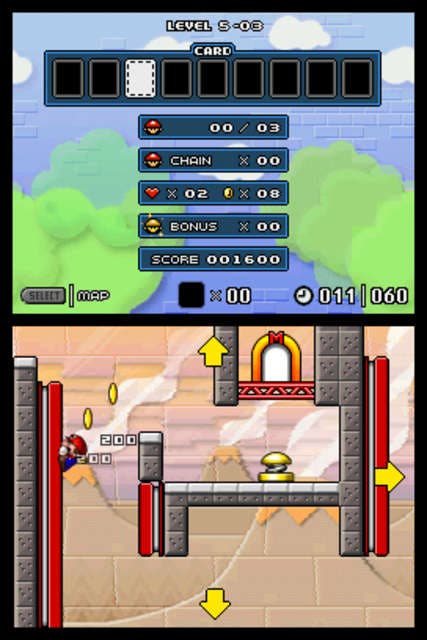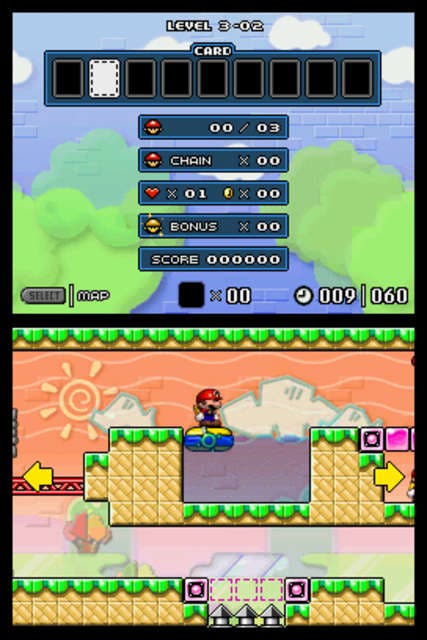Mario Vs Donkey Kong 2: March of the Minis
Toy story too.
As wonderful as the DS' software line-up is, you can't help but get slightly irked when game designers feel the need to make touch-screen based games just because.
Case in point: Mario Vs. Donkey Kong 2. Did it really need to be a touch screen game in order to succeed? Or more to the point, did this game need to be marketed as a sequel to the original to get people's attention? Either way, it's a strange decision, mainly because a) a game that followed on from the GBA original would have done well, and b) plenty of new brands (or brand offshoots) have sold extremely well. People have every right to feel a little disgruntled.
The Mario vs. Donkey Kong we knew and loved on GBA was, undoubtedly, one of the finest showcases of retro design brilliance seen in recent years. It effortlessly took the brand back to the early '80s arcade roots, pairing Mario (a.k.a. Jumpman) against the ruthless Donkey Kong in a series of fiendishly designed platforming levels that provided a welcome taste of what we'd been missing for more than two decades. It was like Donkey Kong Country never happened.
Puzzling decision

Not only did the game remind us of how relevant retrogaming can be in a next gen obsessed world, but how well-suited they are for the bite-sized demands of handheld gaming. Needless to say, the initial prospect of a sequel on the hugely popular DS made it an instant must-have on the system. But that's before we realised that Nintendo had abandoned the pure platform style in favour of simple Lemmings-style puzzling.
The goal of the game couldn't be much easier to grasp. Each level has a number of Mini Mario wind -up toys to guide to an exit, and to progress you must make sure that at least one gets through unscathed.
Flicking the stylus left or right over the Mini Mario sets them in motion in that direction, an upward stroke makes them jump, while a precise tap stops them in their tracks. Beyond that, you're left to your own devices to suss out how to negotiate the various traps and enemies, via assorted switches, elevators, magnetic walls, pipes, and whatnot that constitute each environment.
One into two doesn't go
Slightly unusually, the levels generally take up two or three screen's worth of actual play area, but the action is only displayed on the touch screen (the top screen is used purely as a status indicator), meaning that any parts of the level not immediately on screen have to be accessed via the yellow arrows pointing in the relevant direction at the outer perimeter. This takes a fair bit of getting used to, and perhaps isn't the most graceful design decision ever - mainly because you're forced to gamble on what you can't see. Often, actions that you set in motion on one part of a level have an unseen impact on another - for example, a flicked switch may well upon an unseen door and set free an enemy that gleefully chomps on a Mini Mario that you hadn't accounted for. To be fair, though, the trial and error nature becomes second nature. It's not a game with levels so vast that you'll constantly be making errors that can't be swiftly rectified with another try, put it that way.

Indeed, many have noted that the minimum requirement to progress is spectacularly easy, and that, as such, the game is a little too forgiving. That's true if all you want to do is blitz through it, but the game starts to come into its own if you can be self-motivated to earn the points that award your performance bronze, silver and gold stars. We won't labour that criticism here - that would be as relevant as damning Project Gotham Racing for the lack of challenge it presents on Steel level. On the contrary, it's a game that deserves praise for being easy to unlock, but tough to crack.
The real challenge and the long-term fun within March of the Minis inevitably comes from investing more than the minimum effort required, and toiling over how to not only keep all your Mini Marios alive, but how to get them all to the exit quickly while collecting all the pick-ups along the way. If you do so there are a decent amount of unlockables as a reward, too.
Floored genius
As you work your way through the eight main 'floors', new challenges present themselves at regular intervals. Early on it might be something as simple as using a limited number of coloured blocks to construct a temporary path (which you physically draw in by sliding the stylus across the empty block), and reusing those blocks elsewhere in the level. Later on, you'll learn how to use rotating magnetic strips, or water valves, or balance beams that require multiple Mini Marios to work together. It's a game that always seems to freshen up the task at hand with new hazards and environments, or combinations of obstacles and enemies that you may not have seen for a while.

Like all worthy handheld games, it's one of those that works almost perfectly as a tea break distraction. Each level is a small, digestible chunk that you can 'solve' in a matter of minutes. But the next time you might fancy trying it again - either to pick up one of the letters you missed, or to try and rescue more Mini Marios - or, better still, to get a medal.
Admittedly the boss sections at the end of each 'world' are pretty poor, mainly for being predictable and way too easy. On every occasion, the idea is to fire your Mini Marios from a barrel at the bottom of the screen up towards DK (stationed, as ever, on some girders), while trying to avoid the debris raining down upon you. Half a dozen hits later, Kong sulks off to another 'floor' and so the process begins anew, with another nine puzzle levels unlocking in sequence. If you happen to have collected the M-I-N-I-M-A-R-I-O letters in each stage, then you can also engage in an utterly throwaway shooting gallery minigame where you have to tap the Shy Guys as they emerge from pipes, while trying not to tap the Bob-ombs. To describe these interludes as 'easy' would make typing the word itself appear to be a strange and interesting science.
Easy to miss the point
But don't take too much notice of how 'easy' the game is. Mario vs. Donkey Kong certainly won't stress any hardcore gamer out, but it's a pleasant diversion once it gets into its stride, and definitely has a deceptive depth to it once you start playing it 'properly'. The problem will be whether you have the required motivation to re-do levels once you've 'completed' them. If anything, this is where the game shoots itself in the foot, because it doesn't quite do enough to reward players who go the extra mile. Shame.
Likewise, there are other features that will doubtlessly fall by the wayside, such as the game's level editor that allows you to construct your own puzzle creations and exchange them with friends online. Whether you'll want to take advantage of this is debatable, though. I've yet to meet a single gamer that does this. You can't knock them for putting the option in, I guess.
Strangely, the game is perhaps less technically interesting than the original was, with a clean, minimalist approach to the 2D visuals that gives it a look more akin to 2D Mario games than the DK ones. Meanwhile, in the audio department, numerous Mario tunes are robbed wholesale, giving the whole game much more of a Mario emphasis all round. If the first Mario vs. Donkey Kong tipped its cap to the DK side of the brand, the sequel definitely has more of a moustachioed plumber feel, for what it's worth.
So what's this pleasant puzzle diversion worth in the grand scheme of all things DS? On the plus side there's nothing quite like March of the Minis on the platform; it's yet another game oozing with intuitive Nintendo design genius that makes it an instantly pleasurable game to pick up and enjoy from the start. But although it's the sort of game that lends itself perfectly to short commutes and coffee breaks, its strengths are also its Achilles heel - many won't appreciate the simplicity, or the fact that there doesn't appear to be enough of a substantial challenge to grab your attention for very long. Not for everyone, then, but well worth further investigation if puzzling's your thing.

